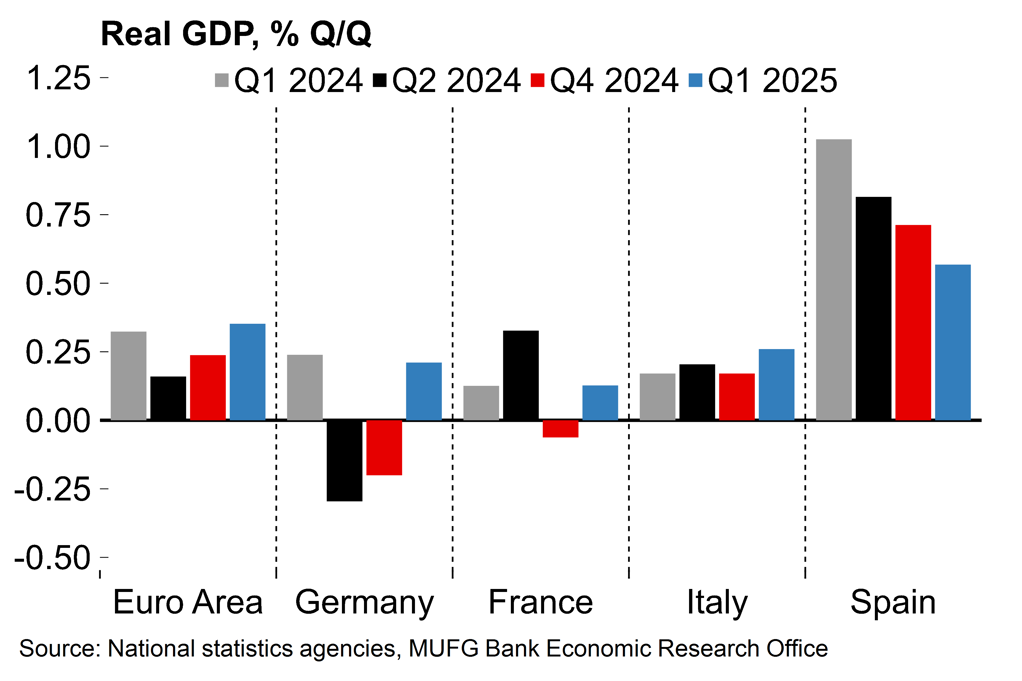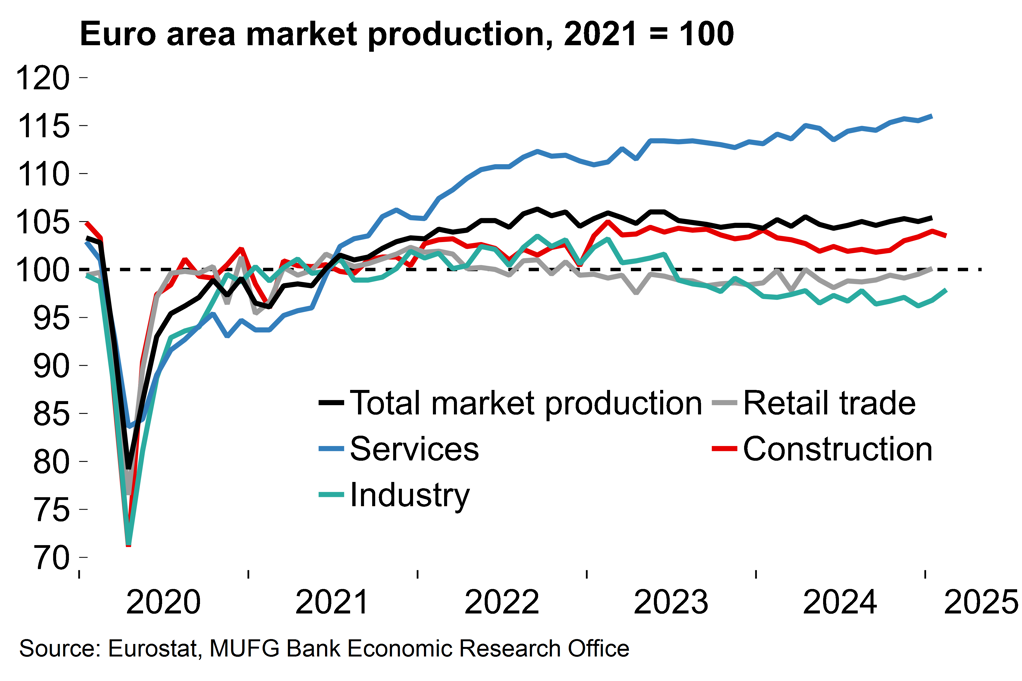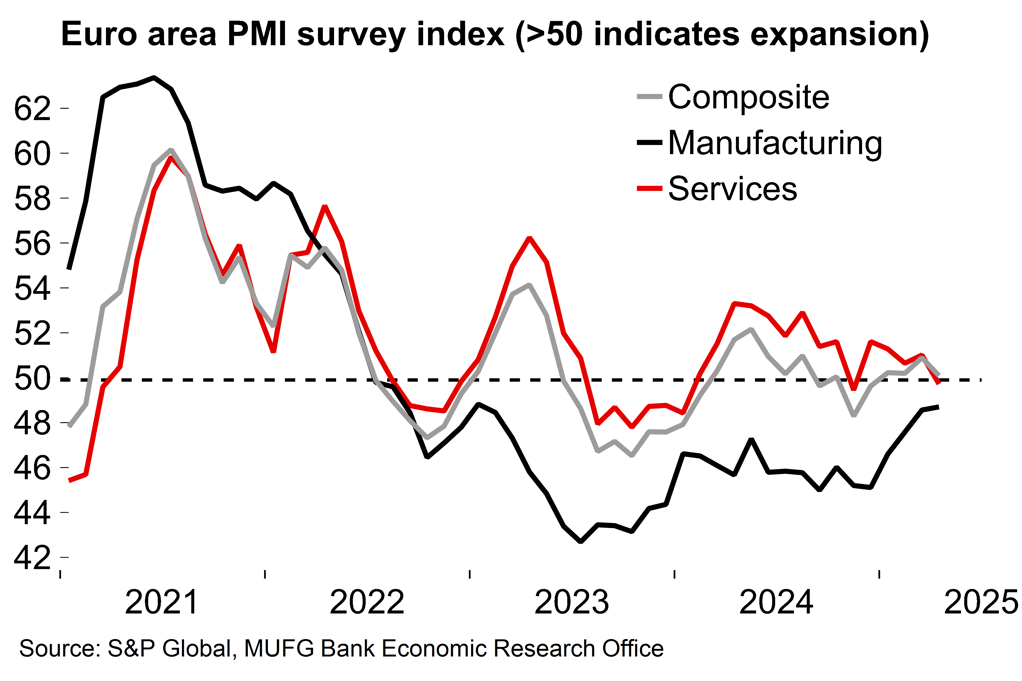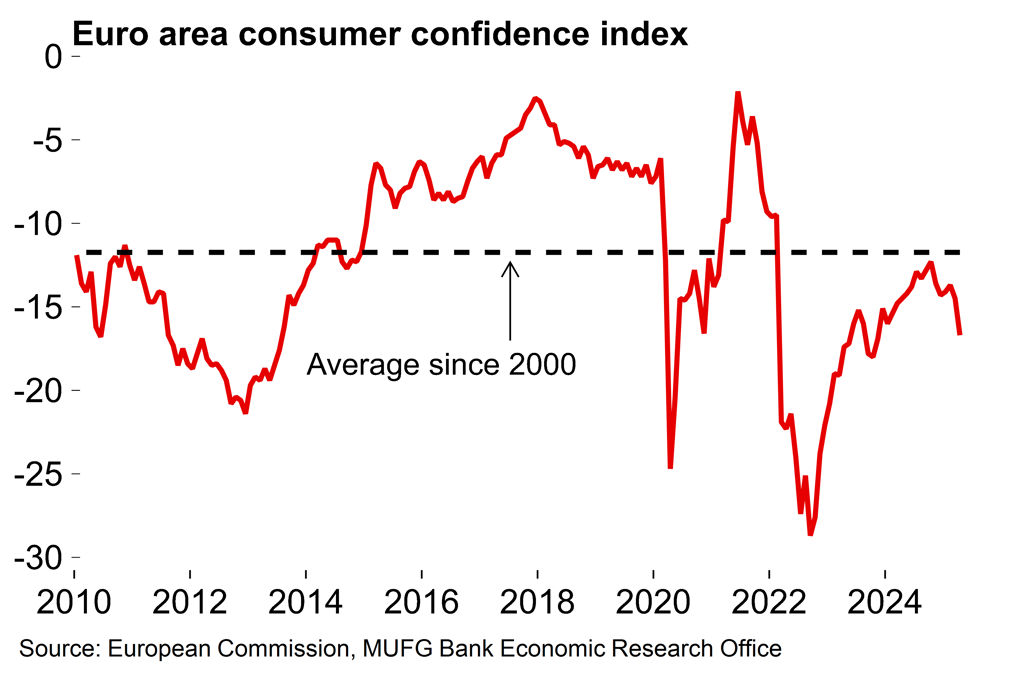The euro area economy started the year on a relatively firm footing with Q1 growth coming in above consensus (+0.4% Q/Q). On a national basis, the major economies were broadly inline with expectations. Germany and France both avoided slipping into a technical recession.
A lot has changed since Q1 and a deceleration is likely once tariff effects take hold, but it is encouraging that the economy has entered this period of US policy volatility with reasonable growth momentum. As things stand, soft data is not yet pointing to sharp slowdown. A mechanical update of our current forecast to reflect Q1 figures lifts the annual average growth rate to 0.9%, which would match last year’s expansion.
The euro area economy started the year on a firmer footing
- The initial estimate of Q1 euro area growth came in at 0.35% Q/Q, above consensus (0.2%). On a national basis, all the major national economies expanded on the quarter, more or less in line with expectations. Both France and Germany avoided slipping into a technical recession after contractions at the end of 2024.
- The German economy grew by 0.2%. The expenditure breakdown is not yet available but the release noted that household consumption and investment contributed positively. Survey signals had suggested that there may have been a boost from US importers looking to get ahead of any tariffs, but net trade was not mentioned.
- In France, the rebound was more muted (0.1% Q/Q). The details were not hugely positive with inventories being the main driver of growth. Fixed investment fell again amid heightened political uncertainty.
- Elsewhere, Italian growth surprised to the upside (0.3% Q/Q). In Spain, growth continued to slow slightly (0.7% to 0.6% Q/Q) but the Spanish economy continues to comfortably outperform the euro area aggregate.
- It’s also worth highlighting that there was another notable distortion from volatile Irish growth (+3.2% Q/Q). Ex-Ireland, euro area growth in Q2 was around 0.2% Q/Q (i.e., in line with expectations).
Expansions across the board in Q1

The fragmented post-pandemic recovery

A decent start to the year, but a deceleration is likely
Q1 GDP growth feels somewhat like ancient history given the 2 April ‘Liberation Day’ tariff announcements and all the subsequent volatility. A deceleration is likely once tariff effects kick in. But it is encouraging that the euro area economy entered this period of US policy volatility with reasonable growth momentum.
In terms of the soft data signals in April, the picture from the surveys has also been slightly better than may have been expected. Yes, the composite euro area PMI weakened, but it still remains (just) above the breakeven mark despite the US protectionist shift. The manufacturing component actually improved in April. This possibly hints at a cyclical upswing for industry, finally, which could go some way to offsetting the trade from tariffs and related policy uncertainty.
If there is one area of particular concern from recent surveys it is household sentiment. Euro area consumer confidence weakened in March and then fell sharply in April, with households increasingly worried about employment conditions and inflation. On the latter, we have highlighted previously that tariff troubles seem less likely to derail the disinflation process given the EU’s clear desire to avoid tit-for-tat escalation. A stronger euro and lower energy prices also look likely to reinforce the drag on price growth from the tariff-related demand shock.
As a result, real wage growth looks likely to remain in positive territory (and, promisingly from a growth perspective, the latest survey suggested that savings intentions have eased slightly) and so consumer sentiment may recover somewhat over coming months. If there is some tariff-related labour market deterioration it would be from a positive of relative strength with the unemployment rate at a historical low.
Euro area business sentiment has held up relatively well post-‘Liberation Day’…

…but consumer confidence has weakened sharply in recent months

Tariff uncertainty continues to loom large over the outlook
The overall picture from recent survey data remains consistent with flattish growth in Q2 rather than a sharp contraction, but business sentiment is set to remain subdued over coming months while US trade policy uncertainty looms over the economy. To our minds, the 90-day reprieve on reciprocal tariffs seems unlikely to pass without further developments given the frequent US announcements on trade policy since inauguration day on 20 January. A lack of clarity will continue to weigh on investment decisions and overall growth. On the other hand, more details on the profile of new German fiscal support could lift sentiment towards the end of H1.
Mechanically adjusting our latest forecasts to account for the Q1 figures lifts the 2025 annual average from 0.7% to 0.9%, which would match last year’s expansion. To be clear, there are plenty of moving parts (e.g. tariffs, fiscal response) and any forecasts at this stage need to be taken with a pinch of salt. But the recent news flow has been broadly encouraging as the euro area economy enters what is set to be a challenging period.
